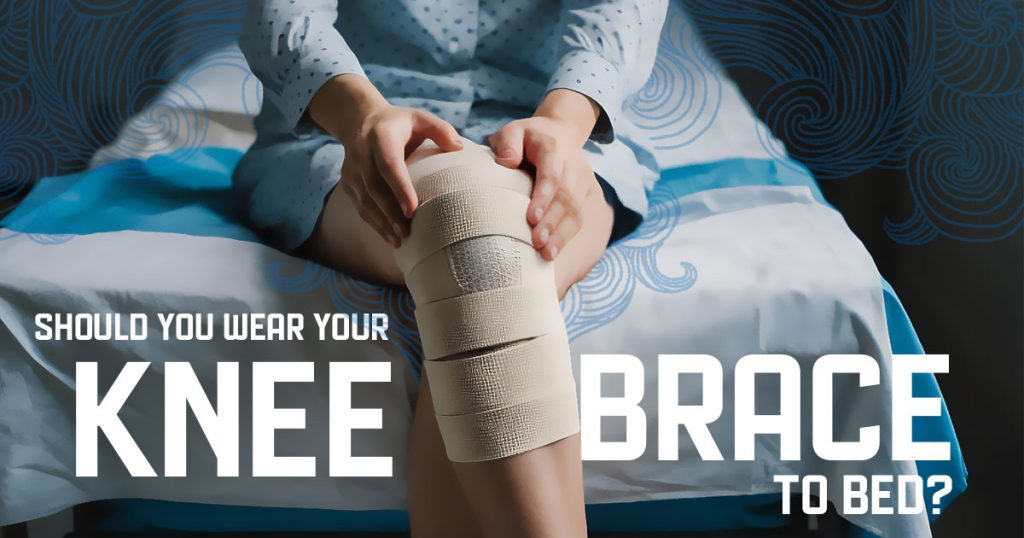Wearing a knee brace during sleep can offer support and stability, especially if you’re recovering from an injury or surgery. However, it’s important to follow certain guidelines to ensure comfort and effectiveness.
Do’s
When considering knee support while sleeping, keep these tips in mind:
Choose the Right Brace
Select a knee brace that fits well and is comfortable. A brace that’s too tight can hinder blood flow, while one that’s too loose won’t offer adequate support. It’s essential to find a balance to ensure both support and comfort during sleep. Consult with a healthcare professional to determine the most suitable type of brace for your specific condition.
Wear Over a Soft Barrier
Place a soft cloth or wear the brace over snug-fitting pants to prevent skin irritation. This reduces friction and enhances comfort during sleep. Skin irritation can lead to discomfort and may discourage consistent use of the brace, which could impede the healing process. Ensuring a barrier between the brace and your skin can help maintain skin integrity and prevent issues such as rashes or pressure sores.
Elevate Your Leg
Use a pillow under your knee to elevate it slightly. This can help reduce swelling and alleviate pressure on the joint. Elevation promotes better blood circulation and can aid in decreasing inflammation, which is crucial for recovery. Additionally, elevating the leg can provide a more comfortable sleeping position, reducing the likelihood of tossing and turning that might disrupt the brace’s position.
Maintain a Comfortable Sleeping Position
Sleeping on your back with a pillow under your knee or on your side with a pillow between your knees can provide additional support and comfort. These positions help maintain proper alignment of the knee joint, reducing strain and promoting healing. Avoiding positions that put unnecessary pressure on the knee can prevent discomfort and potential complications. Experiment with different positions to find what works best for you, and consider using additional pillows for support as needed.
Consult Your Healthcare Provider
Always discuss with your doctor or physical therapist before making changes to your brace-wearing routine. They can provide personalized advice based on your specific condition. Professional guidance ensures that you’re using the brace correctly and not hindering your recovery. They can also recommend specific types of braces or adjustments to your routine that can enhance comfort and effectiveness. Regular check-ins with your healthcare provider can help monitor your progress and make necessary adjustments to your treatment plan.
Don’ts
To avoid potential issues when wearing a knee brace to bed, consider the following:
Avoid Wearing the Brace Over Loose Clothing
Wearing a brace over loose pants can cause it to slip or move out of place, reducing its effectiveness. A brace that doesn’t stay in position won’t provide the necessary support and may even cause additional discomfort. Ensure that the clothing under the brace is snug-fitting to keep the brace securely in place throughout the night. This practice helps maintain the brace’s intended function and prevents unnecessary movement that could irritate the skin or compromise support.
Don’t Ignore Discomfort
If you experience pain, numbness, or tingling while wearing the brace, remove it and consult your healthcare provider. These symptoms could indicate improper fit or other issues. Ignoring discomfort can lead to more serious problems, such as nerve compression or impaired circulation. Addressing these issues promptly ensures that your recovery isn’t hindered and that you’re not causing additional harm. Regularly assess how the brace feels and make adjustments as needed, always in consultation with a professional.
Avoid Sleeping on Your Stomach
This position can put unnecessary strain on your knee and may cause the brace to shift, leading to discomfort. Sleeping on your stomach often forces the knee into an unnatural position, which can exacerbate pain or impede healing. Opt for positions that keep the knee in a neutral, supported alignment to promote comfort and recovery. If you’re accustomed to sleeping on your stomach, it may take time to adjust to a new position, but doing so can significantly benefit your knee health.
Don’t Neglect Regular Maintenance
Keep your knee brace clean and inspect it regularly for signs of wear and tear. A well-maintained brace ensures optimal support and longevity. Accumulated sweat and dirt can lead to skin irritation or infections, while worn-out components may not provide adequate support. Follow the manufacturer’s instructions for cleaning and maintenance, and replace the brace as recommended to ensure it continues to function effectively. Regular maintenance not only preserves the brace but also contributes to your overall comfort and recovery.
Avoid Prolonged Immobilization
While support is essential, it’s also important to engage in gentle movements and exercises as recommended by your healthcare provider to prevent stiffness and promote circulation. Wearing a brace continuously without movement can lead to muscle atrophy and joint stiffness, which may prolong recovery. Incorporate approved exercises into your routine to maintain flexibility and strength in the knee joint. Balancing rest and activity is crucial for effective healing, and your healthcare provider can guide you in creating an appropriate plan.
Making the Right Choice for Nighttime Knee Support
Deciding to wear a knee brace to bed depends on individual circumstances, such as the nature of your injury and your comfort level. Always consult with your healthcare provider to determine the best approach for your specific situation. Remember, proper use of a knee brace is just one component of a comprehensive recovery plan that includes rest, appropriate activity, and professional guidance.
